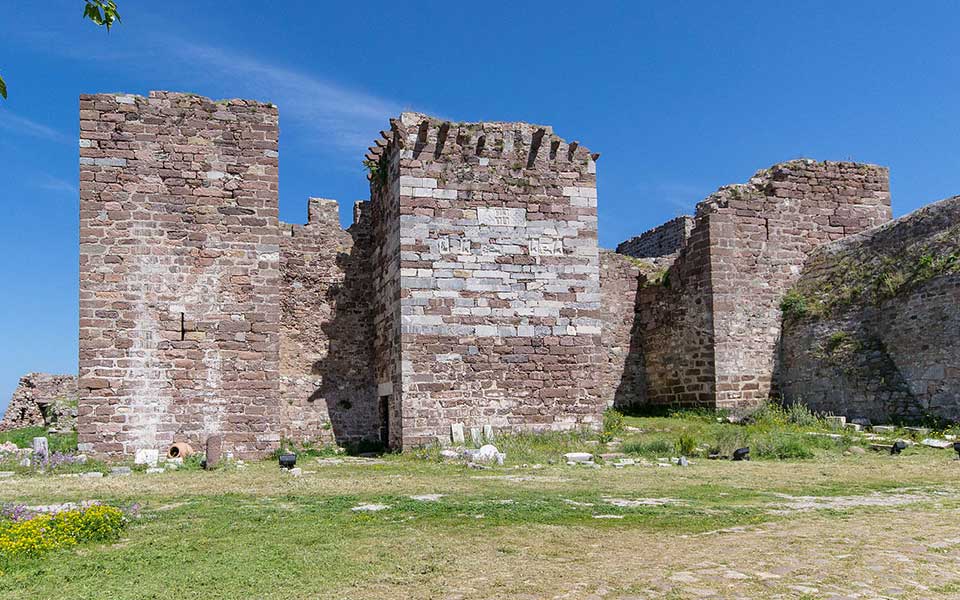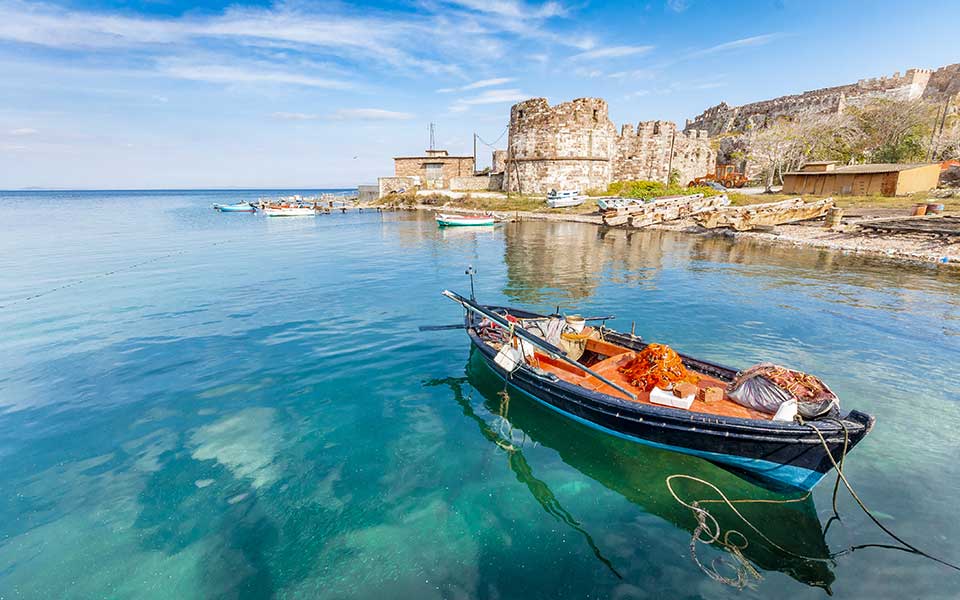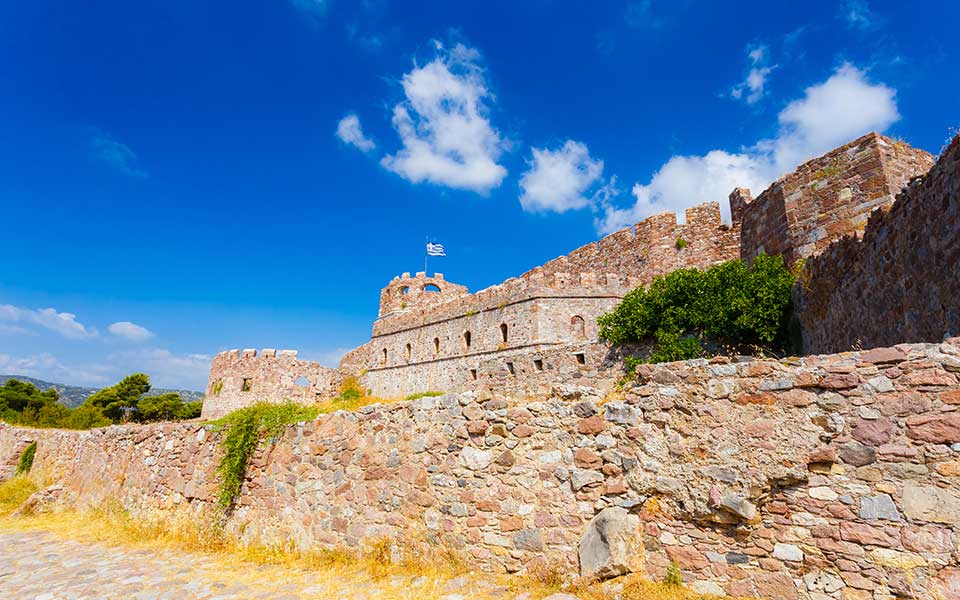The North Aegean island of Lesvos is a place of unique beauty and cultural richness, known for its sprawling olive groves, the ancient Petrified Forest, a UNESCO Global Geopark, and its famous ouzo distilleries. Nestled within this idyllic landscape is the island’s capital, Mytilene, which is dominated by the imposing presence of its medieval castle—a landmark that ranks among the largest and most historically significant fortresses in all of Greece. Spanning an impressive 80,000 square meters, Mytilene Castle has stood the test of time, bearing witness to centuries of upheaval, transformation, and dramatic cultural shifts.
Today, this majestic structure serves not only as a reminder of the island’s storied past but also as a centerpiece of preservation and renewal. Extensive restoration efforts, backed by the Hellenic Ministry of Culture and the European Union, are underway to restore the castle’s grandeur and ensure its legacy endures for generations to come.
We invite you to join us on a journey through the castle’s fascinating history, its intricate architectural design, and the ongoing projects that aim to safeguard this magnificent fortress for the future.

© Katsiaryna Naliuka / Public domain
A Rich Historical Legacy
Perched strategically between the northern and southern ports of Mytilene, offering breathtaking views of the Turkish coastline just across the water, Mytilene Castle has a history that stretches back more than a thousand years. Some historians believe that the first fortress on this site was erected during the reign of Emperor Justinian I in the 6th century AD. However, archaeological evidence suggests even earlier origins, with ancient foundations likely built atop a much older acropolis. This ancient site may have once been a sacred sanctuary dedicated to the gods Demeter, Kore, and Cybele. In fact, the Greek historian Thucydides (460-400 BC) even mentioned that a Temple of Apollo might have once stood here.
Over the centuries, Lesvos fell under the control of various empires, each leaving its mark on the island and its castle. Romans, Byzantines, Genoese, and Ottomans all held sway, and during the Late Middle Ages, the castle became the home of the Genoese noble family, the House of Gattilusio. In the 14th century, this powerful family fortified the structure to protect against invading forces and marauding pirates. The most significant transformations occurred under the rule of Francesco I Gattilusio in 1373, who, as a vassal to his brother-in-law, the Byzantine Emperor John V Palaiologos (1332-1391), was granted the island as a dowry and personal “fief” (estate). Following a devastating earthquake in 1384, which left much of the castle in ruins, major repairs were carried out to restore the fortress to its former glory.

© Hellenic Ministry of Culture
The castle’s fate shifted once again in 1462 when the Ottoman Turks captured the island, marking the start of a new era for both Lesvos and its castle. Sultan Bayezid II undertook modernizations, adding defensive towers and thicker walls to withstand the growing threat of cannon fire. In the 17th century, further enhancements were made under Ottoman rule, including the construction of a wide moat and reinforced walls to bolster the castle’s defenses.
As military technology advanced, the castle’s strategic importance declined, and by the 19th century, it had transitioned from a fortress to a residential area. The once-formidable walls enclosed brothels and military barracks and, following Lesvos’ incorporation into the modern Greek state in 1912, parts of the castle were dismantled to provide building materials for refugee housing, accelerating its deterioration.
Today, what remains of Mytilene Castle stands as a symbol of the island’s resilience and a vivid blend of architectural styles influenced by its Byzantine, Genoese, and Ottoman past. Visitors can explore this unique landmark, where centuries of history are etched into its stone walls.

© Hellenic Ministry of Culture
A Fortress in Three Parts
The Castle of Mytilene is a vast and complex structure, with its expansive grounds divided into three distinct sections: the Upper Castle, Middle Castle, and Lower Castle. These areas, often referred to collectively as the “Great Enclosure,” reflect the castle’s evolution across different eras—from its Byzantine beginnings through Genoese rule and into the Ottoman occupation. Each section captures a unique period in the fortress’s history, offering a glimpse into the defense strategies, daily life, and architectural adaptations that took place over the centuries.

© Hellenic Ministry of Culture
Upper Castle
The Upper Castle, the oldest and most elevated section, stands on the site of the ancient acropolis, where traces of Byzantine walls can still be seen. This area was chosen for its strategic location, providing a commanding view of the surrounding land and sea, making it the ideal site for both defense and control of the region.
During the Byzantine period, the Upper Castle served as the fortress’s core. It housed critical military infrastructure, such as barracks and armories, and was the heart of its defensive operations. The majestic Queen’s Tower, built during the 14th century, is one of the most iconic features of the Upper Castle. As the main residence of the ruling Gattilusio family, it continues to define the silhouette of the fortress and offers a tangible link to its medieval past.

© Hellenic Ministry of Culture
Middle Castle
The Middle Castle represents a transitional phase in the fortress’s history, showcasing architectural influences from both Genoese and Ottoman periods. During the 14th and 15th centuries, the Genoese rulers undertook extensive fortification efforts, bolstering the castle’s defenses to protect against pirate raids and foreign invaders. They added bastions and thick walls capable of withstanding the artillery advancements of the time, though the castle sustained significant damage during the Ottoman conquest of 1462.
In the aftermath, the Ottoman rulers reinforced and modernized the Middle Castle to counter the growing threat of cannon fire, which had become the dominant form of warfare by the 17th century. They constructed massive bastions, fortified gates, and polygonal towers, transforming the Middle Castle into an imposing defensive structure that could fend off naval and land-based assaults. This area of the castle also served as a residential and religious center for the Ottoman rulers, with key buildings such as a “medrese” (religious school), “imaret” (charitable kitchen), and “hammam” (bathhouse) forming part of the daily life of the fortress’s inhabitants. The remains of these structures, including a 17th-century barracks and a massive gunpowder magazine, still stand today, offering visitors a glimpse into the castle’s function as both a military stronghold and a self-sustaining community.
The Middle Castle also holds spiritual significance. Near the path leading through this section, accessible through the Ottoman Orta Kapi (“Middle Gate”), visitors can find a small, domed “tekke,” a residence for dervishes (an Islamic religious fraternity), which includes an intact fireplace, reminding us of the intertwining of military and spiritual life within the fortress.

© Hellenic Ministry of Culture
Lower Castle
The Lower Castle, situated closest to the sea, was primarily used for commercial and residential purposes during the Ottoman period, serving as the crucial link between the fortress and Mytilene’s bustling port. Unlike the heavily fortified Upper and Middle Castles, the Lower Castle was a more active residential area, featuring a range of buildings that supported daily life. Ottoman officials lived in houses scattered throughout this section, alongside an ornate public fountain for water supply, a well-preserved cistern, and a Turkish oracle-shrine.
The Lower Castle was a vibrant hub of activity, with its streets filled with the sounds of trade and daily routines. Although it was less militarized than the upper sections, its walls still offered protection from external threats. In its southwestern corner, visitors can enjoy stunning views of the Aegean Sea and surrounding landscapes. This section of the castle once extended to the northern shore and harbor, where a large bastion protected the area from seaborne attacks. This part of the fortifications also housed a hammam, residences, and the Christian cave-church of Panagia Galatoúsa, complete with its sacred spring.
Together, these three sections of the Castle of Mytilene tell the story of a fortress that evolved through multiple empires, adapting to new challenges and threats while remaining a key part of the island’s social and military fabric.

© Shutterstock
The Restoration Project: Preserving History for Future Generations
In recent years, the Hellenic Ministry of Culture, with significant support from the European Union’s Recovery Fund and the Regional Operational Program of the North Aegean, has launched a bold and ambitious project aimed at restoring and preserving the Castle of Mytilene. Additional backing from the NSRF 2014-2020 and 2021-2027 funds has enabled this initiative to not only protect the castle’s historical integrity but also to make it more accessible as a cultural landmark for visitors. The project is a significant undertaking, reflecting a deep commitment to safeguarding the island’s rich heritage for generations to come.
Overseeing the restoration is the Ephorate of Antiquities of Lesvos, which has already completed a series of essential preparatory studies. These include comprehensive geotechnical, architectural, and structural surveys, focusing on critical areas of the Great Precinct, such as the “Acropyrgos” (the fortified tower) and the gunpowder magazine. These detailed assessments ensure that the restoration is carried out with the utmost respect for the castle’s historical and architectural character, allowing for both modern interventions and the preservation of its ancient legacy.
The restoration project is tackling a wide array of conservation needs, with special attention given to structural repairs, particularly in parts of the castle that have suffered damage from past earthquakes. The restoration team is working diligently to stabilize the walls, towers, and other key structures, while also preserving the unique cultural elements that make Mytilene Castle such a distinctive historical site. The goal is to maintain the delicate balance between restoration and preservation, ensuring the castle’s architectural blend remains intact.

© Hellenic Ministry of Culture
Archaeologists involved in the project have also made remarkable discoveries during the restoration process. They have unearthed a wealth of artifacts, including bronze coins, pottery fragments, and architectural remnants from various eras, offering fascinating glimpses into the daily lives of those who once inhabited the castle. These finds are being carefully cataloged and preserved, shedding new light on the castle’s diverse historical occupants and their cultures.
An important component of the restoration effort is enhancing the visitor experience. Plans are underway to introduce improved signage, guided tours, and multimedia presentations, all designed to offer an immersive journey through the castle’s long and storied history. These additions will help visitors engage more deeply with the site, transforming a walk through the castle grounds into a rich educational experience.
Beyond the physical repairs and enhancements, the project also envisions the castle as a vibrant cultural hub for both locals and tourists. There are plans to host exhibitions, historical reenactments, and educational programs that will breathe new life into the castle’s spaces. The open-air areas within the castle walls are also being considered as venues for summer festivals, which would further integrate the site into the island’s contemporary cultural life, making Mytilene Castle not just a monument of the past but a thriving center for cultural activity today.

© Shutterstock
A Beacon of Cultural Identity
The restoration of the Castle of Mytilene is much more than a preservation effort—it represents a profound reaffirmation of the island’s cultural identity. Over its long and storied history, Lesvos has served as a crossroads for numerous civilizations, and the castle stands as a testament to this rich and diverse heritage. Its unique blend of Byzantine, Genoese, and Ottoman architectural influences reflects the complex past of the island, while its ongoing revival points toward a hopeful and enduring future.
For the people of Mytilene, the castle is not merely a historical artifact but a living monument, deeply woven into the fabric of the community’s identity. Its preservation ensures that future generations will have the opportunity to experience and appreciate the many layers of history embedded within its ancient walls.
As restoration efforts progress, Mytilene Castle is poised to emerge as one of the most significant cultural landmarks in the North Aegean. With its harmonious mix of historical architecture and contemporary cultural programming, the castle promises to attract visitors from around the world, cementing its place as a symbol of resilience and a proud beacon of cultural pride.











